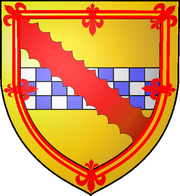Earls of Galloway
| Earldom of Galloway | |
|---|---|
 
Or, a fesse chequy azure and argent, surmounted of a bend engrailed gules, within a double tressure flory counterflory gules
|
|
| Creation date | 19 September 1623 |
| Monarch | James VI and I |
| Peerage | Peerage of Scotland |
| First holder | Alexander Stewart, 1st Earl of Galloway |
| Present holder | Randolph Stewart, 13th Earl of Galloway |
| Heir presumptive | Andrew Clyde Stewart |
| Remainder to | First earl's heirs male of the body |
| Subsidiary titles | Lord Garlies |
| Seat(s) | Cumloden House |
| Former seat(s) | Galloway House |
| Armorial motto | Virescit vulnere virtus ("Courage grows strong at a wound") |
Earl of Galloway is a title in the Peerage of Scotland. It was created in 1623 for Alexander Stewart, 1st Lord Garlies, with remainder to his heirs male bearing the name and arms of Stewart. He had already been created Lord Garlies in the Peerage of Scotland in 1607, with remainder to the heirs male of his body succeeding to the estates of Garlies. This branch of the Stewart family were distant relatives of the Stewart King of Scotland.
Lord Galloway was succeeded by his second but eldest surviving son, the second Earl. He had already been created a Baronet, of Corsewell in the county of Wigtown, in 1627. This title is in the Baronetage of Nova Scotia. His grandson, the fifth Earl (who had succeeded his elder brother, who in his turn had succeeded his father), was a politician. He was succeeded by his son, the sixth Earl. He was a Lord of Police. In 1704 Lord Galloway succeeded his kinsman Sir Archibald Stewart, 2nd Baronet, of Burray, as third Baronet of Burray (see below). On his death the titles passed to his eldest son, the seventh Earl. He was a Member of Parliament and served as Lord-Lieutenant of Wigtownshire. From 1774 to 1796 he sat in the House of Lords as a Scottish Representative Peer. In 1796 Lord Galloway was created Baron Stewart of Garlies in the Peerage of Great Britain, which gave him an automatic seat in the House of Lords. He was succeeded by his son, the eighth Earl. He was an admiral in the Royal Navy, a Member of Parliament and Lord-Lieutenant of Kirkcudbrightshire and Wigtownshire. When he died the titles passed to his eldest son, the ninth Earl. He represented Cockermouth in the House of Commons and was Lord-Lieutenant of Kirkcudbrightshire and Wigtownshire. He was succeeded by his eldest son, the tenth Earl. He sat as Member of Parliament for Wigtownshire. On his death the titles passed to his younger brother, the eleventh Earl. He was a soldier and fought in the Crimean War and in the Indian Rebellion of 1857. He was succeeded by his only son, the twelfth Earl. He served as Lord-Lieutenant of Kirkcudbrightshire. As of 2017[update] the titles are held by his only son, the thirteenth Earl, who succeeded in 1978.
...
Wikipedia
